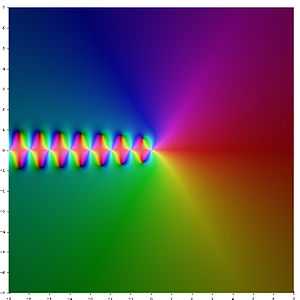Trigamma function

 in the complex plane. The color of a point
in the complex plane. The color of a point  encodes the value of
encodes the value of  . Strong colors denote values close to zero and hue encodes the value's argument.
. Strong colors denote values close to zero and hue encodes the value's argument.In mathematics, the trigamma function, denoted  , is the second of the polygamma functions, and is defined by
, is the second of the polygamma functions, and is defined by
-
 .
.
It follows from this definition that
where  is the digamma function. It may also be defined as the sum of the series
is the digamma function. It may also be defined as the sum of the series
making it a special case of the Hurwitz zeta function
Note that the last two formulæ are valid when  is not a natural number.
is not a natural number.
Calculation
A double integral representation, as an alternative to the ones given above, may be derived from the series representation:
using the formula for the sum of a geometric series. Integration by parts yields:
An asymptotic expansion as a Laurent series is
if we have chosen  , i.e. the Bernoulli numbers of the second kind.
, i.e. the Bernoulli numbers of the second kind.
Recurrence and reflection formulae
The trigamma function satisfies the recurrence relation
and the reflection formula
which immediately gives the value for z=1/2.
Special values
The trigamma function has the following special values:
where K represents Catalan's constant.
There are no roots on the real axis of  , but there exist infinitely many pairs of roots
, but there exist infinitely many pairs of roots  for
for  . Each such pair of root approach
. Each such pair of root approach  quickly and their imaginary part increases slowly logarithmic with n.
E.g.
quickly and their imaginary part increases slowly logarithmic with n.
E.g.  and
and  are the first two roots with
are the first two roots with  .
.
Appearance
The trigamma function appears in the next surprising sum formula:[1]
See also
Notes
- ↑ Mező, István (2013). "Some infinite sums arising from the Weierstrass Product Theorem". Applied Mathematics and Computation 219: 9838–9846. doi:10.1016/j.amc.2013.03.122.
References
- Milton Abramowitz and Irene A. Stegun, Handbook of Mathematical Functions, (1964) Dover Publications, New York. ISBN 0-486-61272-4. See section §6.4
- Eric W. Weisstein. Trigamma Function -- from MathWorld--A Wolfram Web Resource













![\sum_{n=1}^\infty\frac{n^2-\frac12}{\left(n^2+\frac12\right)^2}\left[\psi_1\left(n-\frac{i}{\sqrt{2}}\right)+\psi_1\left(n+\frac{i}{\sqrt{2}}\right)\right]=
-1+\frac{\sqrt{2}}{4}\pi\coth\left(\frac{\pi}{\sqrt{2}}\right)-\frac{3\pi^2}{4\sinh^2\left(\frac{\pi}{\sqrt{2}}\right)}+\frac{\pi^4}{12\sinh^4\left(\frac{\pi}{\sqrt{2}}\right)}\left(5+\cosh\left(\pi\sqrt{2}\right)\right).](../I/m/889b5db8a4801f746b93470924df08e4.png)